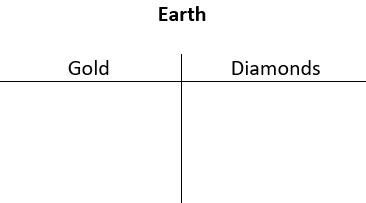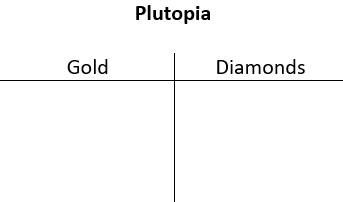
Students will learn about specialization, comparative advantage and opportunity cost and how these key economic concepts help countries around the world benefit from trade. They will participate in hands-on activities to better understand these concepts and make links to today’s global economy.
Overview
Big idea
Specialization offers opportunities for trade to have a positive effect on the economies of all participating countries.
Time
Approx. 60 minutes of instructional time, which could be delivered in one or two classes, depending on the length of the class discussion.
Grade levels
Grades 9 to 12; Secondary II-IV and CEGEP
Subject areas
Economics
- economics fundamental concepts
- the functions of an economic system
- economics of specialization
- comparative advantage, opportunity cost
Math
- represent ratios from realistic situations
- solve problems involving ratios in various contexts
Social Studies
- globalisation and free trade
- economics and resources
Learning objectives
Students will:
- define comparative advantage, opportunity cost and specialization
- explain how, because of opportunity cost and comparative advantage, specialization in trade leads to a better outcome for everyone
- examine and discuss the advantages of trade
Materials
Classroom supplies and technology
- a computer with internet access and a screen or projector to show video
- a white board and white board markers
- pencils and pens
Graphic organizer
Download and print the following:
- Opportunity Cost — Questions — one copy for every two students
- Opportunity Cost — Answers
Online resources
"Trading up: How countries benefit from freer trade": by Stephen Murchison and Alex Chernoff in The Economy, Plain and Simple
Activity 1: What is opportunity cost?
Students will discuss trade, play a short game, and learn about opportunity cost and comparative advantage.
Time
30 minutes
1.1 Opening discussion
Ask your students a couple of questions to get them thinking about trade:
- What does Canada trade and why?
- Why do we trade with other countries?
1.2 Hands-on exercise
Students will play a short game to help them understand opportunity cost.
- Divide the class into two groups. One group will be from Earth, and the other will be from the planet Plutopia. They will be harvesting gold nuggets and diamonds.
- Draw two T-charts on the board, one for each planet. Label one side of each T-chart “Gold” and the other side “Diamonds.”
- Explain the premise of the game:
- The goal of this game is to get as many resources as possible, but you must have some of each. Each team will be responsible for their own production. At the end of each round, teams can trade resources with each other.
- There are three rounds.
- Every round, Earth can choose to harvest either 10 gold nuggets or 10 diamonds.
- Plutopia has a special mining technology that allows them to harvest diamonds faster than Earth. So, every round, Plutopia can choose to harvest either 10 gold nuggets or 30 diamonds.
- At the end of each round, Earth and Plutopia have a chance to meet and trade resources. Teams will have to agree on an exchange rate that they think is fair.
- Teams should keep a tally on the board of how many of each resource they have.
- Totals are calculated at the end of each round, and a grand total is of each resource is calculated at the end of the third round.
- Play three rounds of the game and look at the results together.
- Ask the class:
- Did your planet get the most resources possible? Why or why not?
- What was your strategy?
- Was trading beneficial to both teams?
- What would you do differently next time?
1.3 Video and recap
Play the Bank of Canada’s Comparative advantage and opportunity cost: how economic sharing is caring video.
This video is available with subtitles. A transcript can be downloaded directly from the YouTube page.
Ask the class:
- What is opportunity cost?
- What one planet, country or individual misses out on when they choose one option over another. For example, if Earth chooses to harvest gold nuggets, it misses out on the opportunity to harvest diamonds.
- What is the opportunity cost for Earth every time it chooses to harvest one diamond?
- one gold nugget
- What is the opportunity cost for Plutopia every time they choose to harvest one gold nugget?
- three diamonds
- What is comparative advantage?
- It is the advantage a planet, country or individual has when they can produce a product or resource at a lower opportunity cost.
- Comparative advantage is about managing production to use the available resources in the best way possible.
- In our game, who has the comparative advantage for diamonds?
- Plutopia
- In our game, who has the comparative advantage for gold?
- Earth
- What would have been the ideal harvest and trade for each planet to get the maximum amount of both resources?
- Earth harvests only gold, and Plutopia harvests only diamonds. Plutopia trades diamonds to Earth for gold nuggets.
- Even if Plutopia trades 2 diamonds for 1 gold nugget, they still have more resources than if they have to give up 3 diamonds to harvest 1 gold nugget on their own.
1.4 Recap
Ask the class:
- What is comparative advantage?
- What is opportunity cost?
Opportunity cost doesn’t apply only to planets or countries. Opportunity cost comes into play any time you make a decision. Whatever you choose not to do, buy or create is your opportunity cost.
For example:
- If you can do three homework assignments in one hour or play video games for one hour, what is your opportunity cost of playing video games?
- If you have $50 that you can spend on a new shirt or two new video games, what is the opportunity cost of the shirt?
- If you can make 3 birthday cards or 12 cookies in one hour, what is the opportunity cost of each birthday card? What about each cookie?
Ask the class:
- What was the last decision you made about how to spend your time or money? What was the opportunity cost?
Activity 2: The benefits of trade
In this activity, students learn more about specialization and explore what this means in a world (or universe) of free trade.
Time
30 minutes
2.1 Hands-on exercise
To find the opportunity cost for one product compared with another, look at the two numbers as a ratio or fraction. Then simplify the ratio or fraction to 1 on the side of that product.
Do the following scenario as a class, using the white board:
Earth can produce 8 crates of vegetables in one day or 4 crates of wood (as a ratio, 8:4).
- What is the opportunity cost of 1 crate of wood?
- 8:4 becomes 2:1
- 2 crates of vegetables
- What is the opportunity cost for 1 crate of vegetables?
- 8:4 becomes 1:0.5
- 0.5 of a crate of wood
- If Earth wants to have get the most resources possible out of a day’s labour, what should it make?
- Earth should focus on creating crates of vegetables because the opportunity cost of a crate of vegetables is lower than the opportunity cost of a crate of wood. This is called specialization.
Divide your class into pairs or small groups and distribute the Trading Up - Graphic Organizer. In their groups, students will review the two scenarios and figure out the answers*.
* Answers can be found in the file Trading Up - Graphic Organizer Answers.
2.2 Discussion
Bring the class back together to review the answers.
As a class, discuss:
- How do we use specialization in our lives?
- Few of us grow our own food or do our own dry cleaning. Instead, we specialize in our job, and we trade for the rest, using currency.
- What would the world look like without specialization and trade?
- Not all countries can produce all products. Without trade, we would not be able to eat bananas or oranges in Canada. At least not without a lot of extra work.
- How does specialization help countries?
- Specialization helps each country by allowing it to focus on what it produces at the lowest opportunity cost, so that it can then trade for the rest. And because specialization is more efficient, it creates more wealth than could be created if each country tried to provide for every one of its needs on its own.
- Being able to sell products in other countries allows companies to produce on a much larger scale. Some goods or services might be too expensive to produce just for a small market such as Canada. But if a company can sell to other countries, it has a reason to make more units.
- Making more units brings with it the possibility of lowering overall costs and providing a cost saving that may be passed along to consumers. This creates economic growth and wealth.
Conclusion
Wrap up the lesson by recapping what was learned and by explaining the roles that opportunity cost, comparative advantage and specialization play in trade.
Key takeaways
- Specialization means that countries can focus on areas in which they have a comparative advantage and that limit their opportunity cost.
- Trade creates more wealth. In Canada, roughly one in six jobs is linked to exports, and economists estimate that incomes in Canada are 15 to 40 percent higher thanks to freer trade.
- Trade provides consumers with a greater choice of goods and services at lower prices.
Extensions
- Research the history of economic theory about trade.
- Reflect on the following passage from Adam Smith’s The Wealth of Nations (1776):
“It is the maxim of every prudent master of a family, never to attempt to make at home what it will cost him more to make than to buy. The tailor does not attempt to make his own shoes, but buys them of the shoemaker. The shoemaker does not attempt to make his own clothes, but employs a tailor. The farmer attempts to make neither the one nor the other, but employs those different artificers.
All of them find it for their interest to employ their whole industry in a way in which they have some advantage over their neighbors, and to purchase with a part of its produce, or what is the same thing, with the price of a part of it, whatever else they have occasion for.
What is prudence in the conduct of every private family can scarce be folly in that of a great kingdom. If a foreign country can supply us with a commodity cheaper than we ourselves can make it, better to buy it of them with some part of the produce of our own industry, employed in a way in which we have some advantage.”
- Create your own opportunity cost scenarios using ratios. Try a scenario where you calculate a country’s production in the thousands or tens of thousands.
- Take a look at international trade data with Statistics Canada’s International Trade Explorer, an interactive data visualization tool.
- Examine and compare the North American Free Trade Agreement and the Canada–United States–Mexico Agreement and discuss their impacts on trade in North America. Suggested source: Canada–United States–Mexico Agreement (CUSMA) by Global Affairs Canada.
We want to hear from you
Comment or suggestion? Fill out this form.
Questions? Send us an email.


